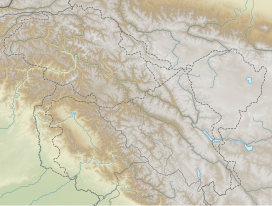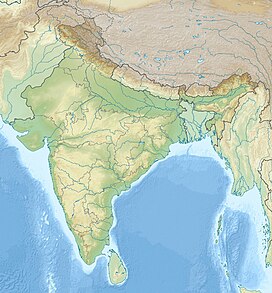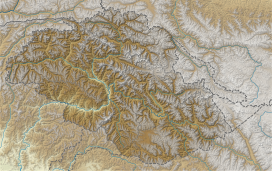Gyong La
| Gyong La | |
|---|---|
 Starting from NJ9842 and going north, Gyong La, Bilafond La, Sia La and Indira Col West are held by India. Masherbrum Range, Baltoro Glacier, Baltoro Glacier, Baltoro Muztagh and K2 are held by Pakistan. | |
| Elevation | 5,686 m (18,655 ft)[1] |
| Location | Karakoram range, Gilgit-Baltistan, Pakistan |
| Range | Eastern Karakoram Range |
| Coordinates | 35°10′29″N 77°4′15″E / 35.17472°N 77.07083°E |
 | |
Gyong La is a mountain pass situated on Saltoro Ridge southwest of the vast Siachen Glacier, some 20 km (12 mi) directly north of map point NJ9842 which defined the end of the 1972 Line of Control between India and Pakistan. With Pakistan controlling areas just to the west along Chumik Glacier, the immediate Gyong La area has been under India's control since 1989.[2][3][4] Dozens of Indian military tents and other equipment are visible in 2013 and 2016 Google Earth imagery 100 meters east, 670 meters northeast, and 2.7 km east-northeast of Gyong La, linked by clear trails. Nearer the former Pakistani "Naveed Top" position and 3.85 km west-northwest of Gyong La is a post and helipad is visible in 2001 and 2016 Google Earth imagery at 5,800 m (19,000 ft) elevation, higher than both the Indian positions and Gyong La.
Background
[edit]
Indo-Pak conflicts
[edit]
Starting in 1984 during Operation Meghdoot, the first military action of the Siachen Conflict, which itself was part of a larger Kashmir conflict, there was military action at Gyong La, and nearby passes Sia La and Bilafond La.[5] Since 1989 Gyong La and Gyong Kangri has been controlled by Pakistan forces, Goma base through Gyong Kangri Pakistan develop proper road and Pakistan forward base camp near Gyong Kangri and Pakistan post Gyong i.e. Gyong and Chumik glaciers to the west.
In March 1989, Operation Ibex by the Indian Army attempted to seize the Pakistani post overlooking the Chumik Glacier. The operation was successful and Pakistani troops from still their positions. The Indian Army under Brig. R. K. Nanavatty then launched an artillery attack on Kauser Base, the Pakistani logistical node on Chumik Glacier. The destruction of Kauser Base induced Pakistani troops to vacate their Chumik posts just west of Gyong La, and Operation Ibex concluded.[6] Pakistan troops still in Chumik Glacier and Chumik Kangri. Chumik Kangri is under Gayari camp.
In June 1999 during the Kargil War, the Indian Army under Brig. P. C. Katoch, Col. Konsam Himalaya Singh seized control of Pt 5770 (which was earlier called Cheema Top & Bilal Top by Pakistan, was renamed to Navdeep Top after victory by India) on the southern edge of the Saltoro defence line, about 20 km southwest of Gyong La, from Pakistan troops.[7] During the capture of Pt 5770 by India, Pakistani Army Captain Taimur Malik of Special Service Group and few other Pakistani soldiers were killed. Pakistan had earlier denied the role of its soldiers in Kargil War and had refused to accept its dead soldiers. However, later Taimur Malik's grandfather made a personal appeal to Indian High Commission (IHC) in London for the return of bodies, the request was forwarded to India's Chief of Army Staff General Malik General Ved Prakash Malik who had the bodies exhumed and sent to Pakistan.[8]
See also
[edit]- Borders
- Actual Ground Position Line (AGPL)
- India–Pakistan International Border (IB)
- Line of Control (LoC)
- Line of Actual Control (LAC)
- Sir Creek (SC)
- Borders of China
- Borders of India
- Borders of Pakistan
- Conflicts
- Kashmir conflict
- Siachen conflict
- Sino-Indian conflict
- List of disputed territories of China
- List of disputed territories of India
- List of disputed territories of Pakistan
- Northern Areas
- Trans-Karakoram Tract
- Operations
- Operation Meghdoot, by India
- Operation Rajiv, by India
- Operation Safed Sagar, by India
- Other related topics
- Awards and decorations of the Indian Armed Forces
- Bana Singh, after whom Quaid Post was renamed to Bana Top
- Dafdar, westernmost town in Trans-Karakoram Tract
- India-China Border Roads
- Sino-Pakistan Agreement for transfer of Trans-Karakoram Tract to China
References
[edit]- ^ "Gyong". Retrieved 6 August 2009.
- ^ Hakeem, Asad; Gurmeet Kanwal; Michael Vannoni; Gaurav Rajen (1 September 2007). "Demilitarization of the Siachen Conflict Zone" (PDF). Sandia Report. Sandia National Laboratories, Albuquerque, NM, USA. Archived from the original (PDF) on 28 January 2017. Retrieved 9 September 2016. See pages 19–20 plus the map on p. 21 outlining in detail Indian control over Gyong La and Pakistani control over the heights immediately to the west (east of Chumik Glacier, the western part of Gyong La), contradicting the oft-copied misstatement in the old error-plagued summary at http://www.globalsecurity.org/military/world/war/siachen.htm ; The article at http://www.outlookindia.com/website/story/tryst-with-deceit/280653 describes 1984–89 Pakistani Gyong La control, and points out that since then, Pakistan has controlled both the Gyong and Chumik Glaciers to the west of Gyong La.
- ^ "A Slow Thaw". Time. 7 November 2005. Archived from the original on 11 September 2005. Retrieved 4 May 2010.
- ^ Joshi, Manoj (2 May 2016). "The Shooting's Over But Siachen Will Keep Taking Its Toll". The Wire, New Delhi, India. Retrieved 9 September 2016.
- ^ Barua, Pradeep P. (30 June 2005). The State at War in South Asia (Studies in War, Society, and the Military). University of Nebraska Press. pp. 253–255. ISBN 978-0-8032-1344-9. Retrieved 6 August 2009.
- ^ The fight for Siachen, Brig. Javed Hassan (Retd) 22 April 2012, The Tribune
- ^ Endgame at Siachen Archived 3 July 2015 at the Wayback Machine, Maj Gen Raj Mehta, AVSM, VSM (Retd) 2 December 2014, South Asia Defence and Strategic Review
- ^ ‘India Handed Over Body of Pakistan Soldier Killed In kargil’, The Sentinel, 28 June 2019.



